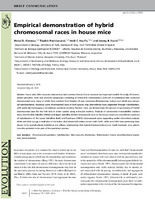Empirical demonstration of hybrid chromosomal races in house mice

Date
2016-06-11Author
Giménez, Mabel Dionisia
Panithanarak, Thadsin
Hauffe, Heidi Christine
Searle, Jeremy B.
Metadata
Show full item recordAbstract
Western house mice (Mus musculus domesticus) and common shrews (Sorex araneus) are important models for study of chromosomal speciation. Both had ancestral karyotypes consisting of telocentric chromosomes, and each is subdivided into numerous chromosomal races many of which have resulted from fixation of new mutations (Robertsonian fusions and whole‐arm reciprocal translocations). However, some chromosomal races in both species may alternatively have originated through hybridization, with particular homozygous recombinant products reaching fixation. Here, we demonstrate the process of generation of hybrid chromosomal races for the first time in either species using molecular markers. Analysis of centromeric microsatellite markers show that the Mid Valtellina (IMVA) and Upper Valtellina (IUVA) chromosomal races of the house mouse are recombinant products of hybridization of the Lower Valtellina (ILVA) and Poschiavo (CHPO) chromosomal races, supporting earlier theoretical analysis. IMVA and IUVA occupy a small area of the Italian Alps where ILVA makes contact with CHPO. IUVA and CHPO have previously been shown to be reproductively isolated in one village, emphasizing that hybrid chromosomal races in small mammals, as in plants, have the potential to be part of the speciation process.
Collections
The following license files are associated with this item:



